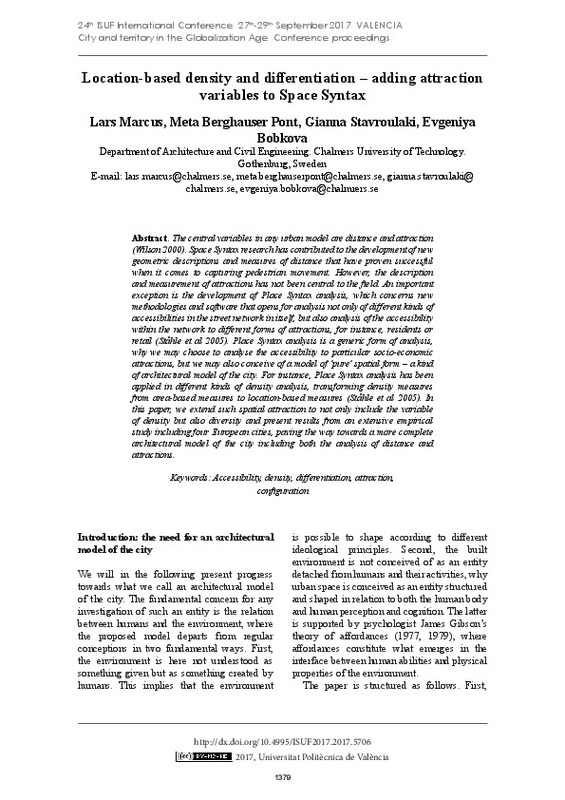JavaScript is disabled for your browser. Some features of this site may not work without it.
Buscar en RiuNet
Listar
Mi cuenta
Estadísticas
Ayuda RiuNet
Admin. UPV
Location-based density and differentiation– adding attraction variables to space syntax
Mostrar el registro sencillo del ítem
Ficheros en el ítem
| dc.contributor.author | Marcus, Lars
|
es_ES |
| dc.contributor.author | Berghauser Pont, Meta
|
es_ES |
| dc.contributor.author | Stavroulaki, Gianna
|
es_ES |
| dc.contributor.author | Bobkova, Jane
|
es_ES |
| dc.date.accessioned | 2018-12-17T09:25:21Z | |
| dc.date.available | 2018-12-17T09:25:21Z | |
| dc.date.issued | 2018-04-20 | |
| dc.identifier.isbn | 9788490485743 | |
| dc.identifier.uri | http://hdl.handle.net/10251/113900 | |
| dc.description.abstract | [EN] The central variables in any urban model are distance and attraction (Wilson 2000). Space syntax research has contributed to the development of new geometric descriptions and measures of distance that have proven successful when it comes to capturing pedestrian movement. However, the description and measurement of attractions has not been central to the field. An important exception is the development of Place Syntax analysis, which concerns new methodologies and software that opens for analysis not only of different kinds of accessibilities in the street network in itself, but also analysis of the accessibility within the network to different forms of attractions, for instance, residents or retail (Ståhle et al 2005). Place Syntax analysis is a generic form of analysis, why we may choose to analyse the accessibility to particular socio-economic attractions, but we may also conceive of a model of ‘pure’ spatial form – a kind of architectural model of the city. For instance, Place Syntax analysis has been applied in different kinds of density analysis, transforming density measures from area-based measures to location-based measures (Ståhle et al 2005). In this paper, we extend such spatial attraction to not only include the variable of density but also diversity and present results from an extensive empirical study including four European cities, paving the way towards a more complete architectural model of the city including both the analysis of distance and attractions. | es_ES |
| dc.format.extent | 11 | es_ES |
| dc.language | Inglés | es_ES |
| dc.publisher | Editorial Universitat Politècnica de València | es_ES |
| dc.relation.ispartof | 24th ISUF International Conference. Book of Papers | es_ES |
| dc.rights | Reconocimiento - No comercial - Sin obra derivada (by-nc-nd) | es_ES |
| dc.subject | Accesibility | es_ES |
| dc.subject | Density | es_ES |
| dc.subject | Differentiation | es_ES |
| dc.subject | Attraction | es_ES |
| dc.subject | Configuration | es_ES |
| dc.title | Location-based density and differentiation– adding attraction variables to space syntax | es_ES |
| dc.type | Capítulo de libro | es_ES |
| dc.type | Comunicación en congreso | es_ES |
| dc.identifier.doi | 10.4995/ISUF2017.2017.5706 | |
| dc.rights.accessRights | Abierto | es_ES |
| dc.description.bibliographicCitation | Marcus, L.; Berghauser Pont, M.; Stavroulaki, G.; Bobkova, J. (2018). Location-based density and differentiation– adding attraction variables to space syntax. En 24th ISUF International Conference. Book of Papers. Editorial Universitat Politècnica de València. 1379-1389. https://doi.org/10.4995/ISUF2017.2017.5706 | es_ES |
| dc.description.accrualMethod | OCS | es_ES |
| dc.relation.conferencename | 24th ISUF 2017 - City and Territory in the Globalization Age | es_ES |
| dc.relation.conferencedate | Septiembre 27-29,2017 | es_ES |
| dc.relation.conferenceplace | Valencia, Spain | es_ES |
| dc.relation.publisherversion | http://ocs.editorial.upv.es/index.php/ISUF/ISUF2017/paper/view/5706 | es_ES |
| dc.description.upvformatpinicio | 1379 | es_ES |
| dc.description.upvformatpfin | 1389 | es_ES |
| dc.type.version | info:eu-repo/semantics/publishedVersion | es_ES |
| dc.relation.pasarela | OCS\5706 | es_ES |








